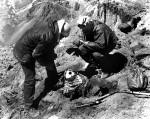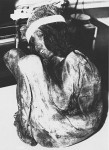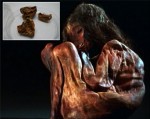 When a member of a mountaineering club first spotted what would prove to be the frozen mummy of an Inca child 17,400 feet up Argentina’s Aconcagua Mountain in 1985, he mistook it for a patch of grass. The other climbers, knowing grass didn’t grow at that altitude, checked it out and found not vegetation, but black and yellow feathers on the headdress of a young boy who had been sacrificed on the mountain 500 years earlier. With only part of the mummy exposed by erosion, the climbers wisely left it alone and returned to the city of Mendoza at the foothills of the Andes where they alerted archaeologist Dr. Juan Schobinger to the find. Fifteen days later, Schobinger and a team of volunteer archaeologists climbed the mountain and carefully excavated the mummy bundle.
When a member of a mountaineering club first spotted what would prove to be the frozen mummy of an Inca child 17,400 feet up Argentina’s Aconcagua Mountain in 1985, he mistook it for a patch of grass. The other climbers, knowing grass didn’t grow at that altitude, checked it out and found not vegetation, but black and yellow feathers on the headdress of a young boy who had been sacrificed on the mountain 500 years earlier. With only part of the mummy exposed by erosion, the climbers wisely left it alone and returned to the city of Mendoza at the foothills of the Andes where they alerted archaeologist Dr. Juan Schobinger to the find. Fifteen days later, Schobinger and a team of volunteer archaeologists climbed the mountain and carefully excavated the mummy bundle.
This was a milestone in the history of mountain archaeology because it’s extremely rare that the professionals get to excavate the find before the people who discover it. Folks just can’t resist having a dig, sometimes because they were only up there in the first place looking for ancient treasure, as in the case of the El Plomo Mummy found in the Chilean Andes in 1954, or because they thought it was a recent death and called the cops, as in the case of Otzi the Iceman or out of simple curiosity.
 The Aconcagua Mountain region in northwest of Argentina was once part of Collasuyu, the southern-most province of the Inca Empire. It was in this empire that lasted less than 100 years from 1438 A.D. until the Spanish conquest in 1532 A.D. that mountain sacrifices reached their apogee. The Incas built shrines at the peak of the highest mountains — Aconcagua is the highest mountain in the world outside of Asia — and there practiced the ceremony of capacocha, the ritual sacrifice of children on occasions of great import like the death of an emperor or in the wake of a natural disaster. The children selected were the most beautiful and healthiest in the empire. They would be given narcotics and alcohol, taken to mountaintop shrines and either left to die of exposure or killed outright.
The Aconcagua Mountain region in northwest of Argentina was once part of Collasuyu, the southern-most province of the Inca Empire. It was in this empire that lasted less than 100 years from 1438 A.D. until the Spanish conquest in 1532 A.D. that mountain sacrifices reached their apogee. The Incas built shrines at the peak of the highest mountains — Aconcagua is the highest mountain in the world outside of Asia — and there practiced the ceremony of capacocha, the ritual sacrifice of children on occasions of great import like the death of an emperor or in the wake of a natural disaster. The children selected were the most beautiful and healthiest in the empire. They would be given narcotics and alcohol, taken to mountaintop shrines and either left to die of exposure or killed outright.
The Aconcagua child appears to have been killed by a blow to the head when he was about seven years old. The cold and dry of the Andean environment preserved his body, the two wool tunics he was wearing, the wool, hair and vegetable sandals on his feet, and multiple layers of cotton cloths and fiber cords wrapped around him, included the outermost wrap festooned with yellow parrot feathers. A total of 25 textiles were found in the bundle. Because the mummy was excavated with proper archaeological procedures, the exceptional preservation was maintained and additional objects were found in the fill underneath the child: six figurines, three human with clothes and feather accessories, and three stylized flames, one gold-plated and two made of Spondylus shell.
Preserved first by 500 years in a frigid and arid climate and then by careful archaeological practice — a replica is on display at the Archaeological Museum of Cuyo while the mummy itself is kept in a freezer at all time — the Aconcagua mummy was a rare pristine subject for interdisciplinary studies. Researchers found red dye, probably from the achiote tree, on his skin and a red liquid, also probably involving achiote, in his stomach. He’s been examined by medical doctors to determine cause of death, been subject to histological, microbiological, osteological, genetic and environmental analysis. He’s been X-rayed and CT scanned.
 Now a team of geneticists has has mapped his mitochondrial genome, a first for any Native American mummy. In fact, not only is he the first Native American mummy whose full mitochondrial DNA has been successfully extracted, he’s the first for whom complete sequencing has even been attempted. Geneticist Antonio Salas from the University of Santiago de Compostela had high hopes that the Aconcagua mummy’s unique preservation conditions might have preserved enough of his DNA to be testable. A small sample of the child’s lung was tested — internal organs are less likely to be contaminated — and all 37 genes passed down from his mother were sequenced.
Now a team of geneticists has has mapped his mitochondrial genome, a first for any Native American mummy. In fact, not only is he the first Native American mummy whose full mitochondrial DNA has been successfully extracted, he’s the first for whom complete sequencing has even been attempted. Geneticist Antonio Salas from the University of Santiago de Compostela had high hopes that the Aconcagua mummy’s unique preservation conditions might have preserved enough of his DNA to be testable. A small sample of the child’s lung was tested — internal organs are less likely to be contaminated — and all 37 genes passed down from his mother were sequenced.
The boy’s pattern of genetic variations placed him in a population called C1b, a common lineage in Mesoamerica and the Andes that dates all the way back to the earliest Paleoindian settlements, more than 18,000 years ago. But C1b in itself is very diverse — as its members spread throughout Central and South America, smaller groups became isolated from one another and started developing their own particular genetic variations. As a result, C1b contains many genetically distinct subgroups. The Aconcagua boy’s genome didn’t fit into any of them. Instead, he belonged to a population of native South Americans that had never been identified. Salas and his team dubbed this genetic group C1bi, which they say likely arose in the Andes about 14,000 years ago. They detail their findings today in Scientific Reports.
When Salas combed through genetic databases, ancient and modern, he found just four more individuals who appear to belong to C1bi. Three are present-day people from Peru and Bolivia, whereas another sample comes from an individual from the ancient Wari Empire, which flourished from 600 to 1000 C.E. and predated the Inca in Peru. Clearly, C1bi is extremely rare today, but the fact that it has now popped up in two ancient DNA samples suggests that it could have been more common in the past, says Andrés Moreno-Estrada, a population geneticist who studies the Americas at Mexico’s National Laboratory of Genomics for Biodiversity in Irapuato and was not involved in the current work. If you sample just one or two individuals, “what are the chances that you pick the rare guy?” he says. “Most likely, you’re picking the common guy.”
It’s likely only so rare today because the Spanish and their diseases did such a thorough job of annihilating the native population. An estimated 90% were dead shortly after the conquest, and the rest interbred with Europeans, other Native American groups and Africans imported to the continent as slaves making the genes of modern Central and South Americans very distant indeed from the ones of their pre-conquest ancestors. The mummy’s DNA is frozen in time just as he was, providing us a rare window into past peoples. For instance, we know now that it took only 4,000 years for the earliest migrants to America to travel from Alaska to the Andes. The speed with which the continent was populated has been much debated, so this is very signficant new information.
Salas plans to go even further. He is working on mapping the complete nuclear genome of the Aconcagua mummy and when that’s done, he will turn his attentions to sequencing the genome of all the microorganisms in the boy’s digestive tract. That would lend new insight into the evolution of the microorganisms that live inside of us, helping us or actively trying to kill us.
You can read the full study here.
I have a bookmarks folder that I labelled “arch & anth”. I’ve found that the bookmarks are now dominated by genetics articles. “anth”, in particular, seems to be of rapidly declining interest, to me at least. Mind you, that’s probably partly because I suspect much of it to be trivial, dishonest or incompetent. At least with the genetics work you can hope that a blunder will be caught fairly quickly by other workers.
Poor little bugger.
So we’ve gone from murdering children as ritual sacrifice to firing people for admissions or omissions of political correctness or the lack of, as ritual sacrifice. Progress!!
considering the barbarism of ISIS, it’s a reminder that no matter how far we’ve come it’s never far enough to, and we’re still dangerously close to the animals that are our ancestors.
one thing…maybe he was the rare guy. he was rare enough to have the bet preserved body for study. maybe that was because his lineage and genes were different from others found. that would make him the RARE guy.
Quackademia has become quite famous for the obvious corruption of history; this team is no exception due to a deep, DEEP secret a certain tr”ibe needs to keep buried.
1) Genocidal destructions for whatever reason never is complete; ‘interbreeding’ does NOT erase your DNA. OMG! This is obvious crap!
The most likely reason for this is due to the ancient betrayals of neighbors of the so-called “White Indians”. Archeology suggests they were betrayed from the inside based on the Chachapoya digs. Some digs found even their eating utensils were among the bones found at their mass murder site. (Think Cosa Nostra; they too are known for throwing murder “parties”.)
What better way of getting rid of pesky, but powerful property owners? The Masons have been using this same tactic. It may well date from the start of the race war against Occidental tribes, well documented in Mayan artwork. These tribes had to run for their lives into the hills due to what they called the “sacrificers”; something about ‘white’ joojoo is more powerful as they’re still hunting and stealing our children to this day.
In Africa too light skinned children have to be kept on a short leash or they’ll disappear due to yielding top dollar.
You’ll find evidence of this coverup in quackademic articles of the Spanish destruction of the Guanche natives. Always left out was they were Occidentals destroyed to the man, but the women were likely enslaved.
Whenever a “European”,[they were NATIVE!], is dug up in America they’re quickly either buried or, if too much coverage escapes, they’re given to the other native tribes for BS reasons.
The following BS quote was also found in “ScienceMag” and any monkey in the zoo can see through the crap! The same betrayal can be found in the Maori oral tradition where their Occidental native neighbors were had, shall we say, over for dinner. (They knew not they were the main course, and some still exist there today. DNA has proven their “Indo-European”. (“Euros” were on every continent, including Japan where they’re called Ainu.)
“It’s likely only so rare today because the Spanish and their diseases did such a thorough job of annihilating the native population. An estimated 90% were dead shortly after the conquest, and the rest interbred with Europeans, other Native American groups and Africans imported to the continent as slaves making the genes of modern Central and South Americans very distant indeed from the ones of their pre-conquest ancestors.”
Okay boomer
you’re fucking crazy dude, take your meds
child sacrifice is evil